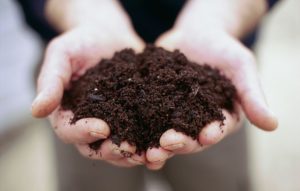
The Low-Down on Composting
 Compost: black gold for your garden
Compost: black gold for your garden
By Thomas Christopher
I once wrote a whole book about composting. Compost This Book was the title and it explored all the refinements of the process including how to cook a chicken in your compost heap (I do not recommend this, although I survived the experience). Autumn in the North Country, though, with its torrent of falling leaves, is more about just getting the job done.
I do wonder at those spendthrifts who stuff their leaves into sacks or rake them out to the curb to be hauled away. From a gardener’s perspective, all that organic debris is the richest harvest of the year, the one that nurtures all the other harvests you may gather from your property. Indeed, to deprive your landscape of the compost from those leaves is to slowly but surely starve its soil. Garden soils don’t need much organic content – even the famously rich soils of our virgin prairies contained only 5-6 percent organic material – but that small admixture makes all the difference between sterility and fertility. When decomposed into humus, the organic content of the soil not only contributes most of its plant nutrients, it also serves as a glue to hold particles of clay, silt and sand together into larger crumbs, helping to aerate the soil and improving its ability to absorb and retain water. Finally, the organic content of the soil is also essential to the survival of its micro-flora and fauna, the fungi, bacteria and tiny creatures that enable any healthy soil to function as a living system.
When I wrote Compost This Book I was younger and a great advocate of hard work. I recommended shredding fall’s leaf harvest with a lawn mower or electric leaf shredder and then mixing this carbon-rich material with a nitrogen source such as fresh manure or fresh lawn clippings to promote a fast, high-temperature decomposition. As a rule of thumb, I suggested mixing two parts of the brown, dry fall leaves to one part of green and juicy material such as fresh manure or grass clippings. The advantage of such a blend is that, especially if turned occasionally with a garden fork, it will heat up to 150°F, hot enough to kill most weed seeds and soil pathogens.
That’s still true, but these days I’m not in such a hurry, nor am I such a glutton for hard labor. I’m perfectly content now just to blow all my acre’s-worth of leaves, unshredded, into a big windrow at the edge of the surrounding woods and let them decompose at their own rate. This can take a couple of years, but the result is still a pile of black, crumbly compost.
My wife and I also compost all the vegetable waste from our kitchen and vegetable garden. Because I no longer do what’s necessary to make the heap heat up, we observe a couple of restrictions when feeding it. We don’t add weeds, at least not those that have gone to seed. That’s because the weed seeds would survive the slow, cool decomposition process and we would sow them back into the garden when we dug in the compost. Also, we don’t add to our compost heap debris from plants such as tomato vines infected with fungal diseases such as early or late blight – the spores would survive the decomposition process and the resulting compost would be a source of further infection. And of course, we don’t add meat scraps or dairy waste, as that would attract rodents or, worse yet, bears. Some types of wildlife are just not welcome in my garden.
Thomas Christopher is the co-author of “Garden Revolution” (Timber Press, 2016) and is a volunteer at Berkshire Botanical Garden. berkshirebotanical.org
Be-a-Better-Gardener is a community service of Berkshire Botanical Garden, one of the nation’s oldest botanical gardens in Stockbridge, MA. Its mission to provide knowledge of gardening and the environment through 25 display gardens and a diverse range of classes informs and inspires thousands of students and visitors on horticultural topics every year. Thomas Christopher is the co-author of Garden Revolution (Timber press, 2016) and is a volunteer at Berkshire Botanical Garden. berkshirebotanical.org.


